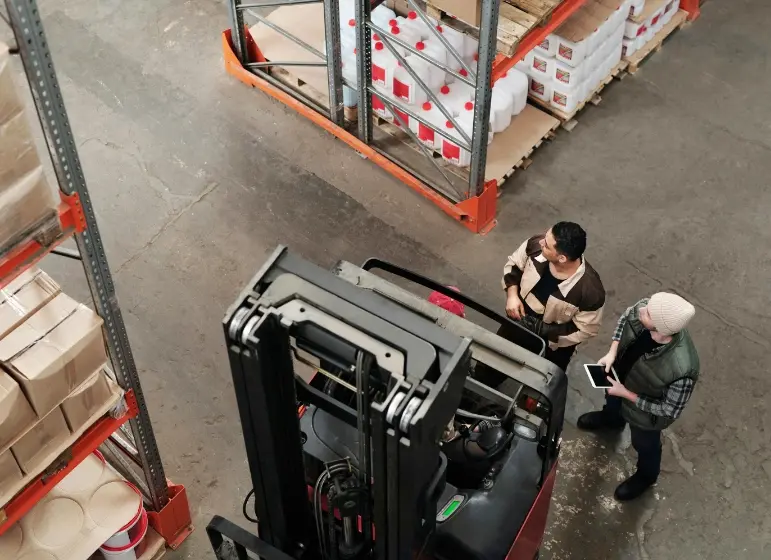
Australia’s weather can change quickly — a week of dry heat can be followed by torrential rain or sudden storms. For businesses that rely on material handling equipment like forklifts, container ramps, and loading platforms, extreme weather isn’t only uncomfortable; it’s a real operational and safety challenge. The good news is that with a few practical measures, you can protect staff, safeguard equipment and keep your workflow moving even when conditions turn against you.
1. Protect equipment from moisture, heat and corrosion
Your forklifts, pallet jacks and loading ramps are the heart of daily operations. When exposed to heavy rain or high humidity, moisture can accelerate rust and corrosion, interfere with electrical systems and degrade components. In extreme heat, hydraulic systems may overheat and rubber seals can age faster. Whenever possible, park equipment under cover and use weatherproof tarps or awnings for outdoor storage. If indoor storage is limited, transparent canopies over loading areas can reduce exposure while preserving visibility.
2. Keep surfaces safe and non-slip
Wet or dusty surfaces are a common cause of slips and product damage. Metal ramps, platforms and tynes become particularly hazardous when wet or covered in condensation. Rather than relying solely on signs, invest in non-slip surface treatments, gritted coatings or open-grate decking on loading platforms. These solutions increase traction and reduce the number of incidents caused by wet conditions — a simple intervention that saves time and money in the long run.
3. Temperature matters — adjust maintenance and usage
High temperatures affect both people and machines. Heat can thin hydraulic fluids and increase tyre pressures; engines and batteries run hotter, and operator fatigue rises. Schedule equipment inspections more often during heatwaves and allow cooling periods for high-use machines. In colder climates or during early-morning shifts, be aware of frost and condensation. Even minor surface ice or morning dew on ramps can create a significant hazard — particularly where forklifts are in use.
4. Train staff to be weather-aware
People are the most important element of any safety system. Regularly train operators and warehouse staff on how extreme weather alters risk. Teach reduced-speed handling for wet conditions, correct tyre inflation practices for heat, and the importance of hydration and rest during hot shifts. Encourage pre-start checks that focus on weather-sensitive items such as brake function, tyre condition and hydraulic hoses. A workforce that understands the ‘why’ behind procedures is more likely to follow them.
5. Secure outdoor storage and control loose items
Strong winds or storms can turn unsecured pallets, packaging and signage into dangerous debris. In exposed yards, secure lightweight items and stack pallets safely. Consider anchoring or stowing portable ramps and attachments; when not in use, lay them flat and ensure safety chains and locking pins are engaged. If you move freight in and out of shipping containers, make sure your container ramps have reliable safety chains and a non-slip surface — these small details matter when surfaces are wet or gusts are strong.
6. Plan for downtime and maintain productivity
There will be times when outdoor work is unsafe. Lightning storms, flash flooding and extreme winds are legitimate reasons to pause operations. Instead of losing time, have alternative tasks ready: equipment maintenance, inventory checks, training modules or indoor assembly tasks. Rotating teams can keep productivity healthy without risking safety. Investing in durable, low-maintenance equipment reduces the likelihood of weather-related breakdowns, so you spend less time reacting and more time operating.
7. Audit your site and improve drainage and shelter
Look at your site through a weather lens: where does water gather, where does wind funnel and which areas bake in sun? Improving drainage, adding gutters to loading shelters and creating covered walkways all reduce exposure to wet or hot conditions. A small investment in shade and shelter — even simple shade cloth over break areas — makes life safer for staff and extends the life of exposed equipment.
8. Choose the right ramps, platforms and materials
Not all ramps and platforms react the same way to weather. Aluminium ramps resist corrosion and are lighter to handle, while galvanised steel ramps offer excellent durability and grip in wet conditions. For businesses operating outdoors a lot, prioritise weather-rated equipment with sealed bearings, protected hydraulics and finishes designed for salt, rain and heat exposure. The right ramp doesn’t only improve safety — it makes everyday operations faster and more reliable.
Final thoughts: safety is the best resilience strategy
Extreme weather is part of the operational reality in many parts of Australia. But it's not something you have to simply endure. With sensible equipment choices, regular maintenance, an attentive workforce and a few smart site changes, you can reduce risk, prevent downtime and protect both people and assets. Quality material handling gear — container ramps, loading platforms and forklifts designed for the environment — paired with regular audits and training, will keep your operation safe and productive no matter the forecast.
If you’d like more information or help picking the right container ramps, loading platforms or outdoor handling equipment for harsh conditions, the All Handling Solutions team can recommend fit-for-purpose options. Contact us to discuss durable ramps, galvanised working platforms and forklift fork extensions that stand up to the elements.